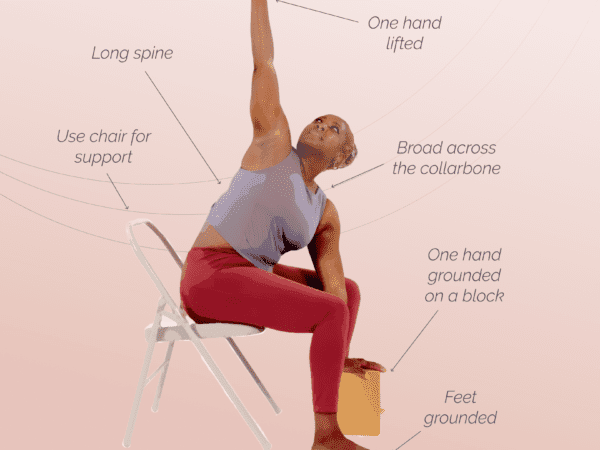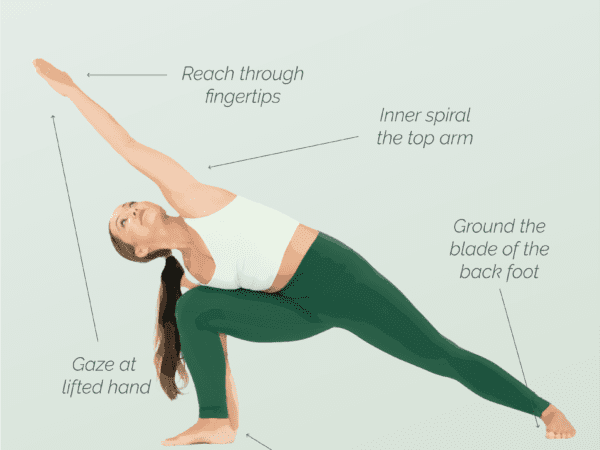This is the first real challenging arm balance of the Ashtanga Yoga Primary series. It helps build self-confidence and strengthens your shoulders and core.
Bhujapidasana gives you the tools to tackle the progressively more challenge arm balances that come up as you practice.
First, we’ll look at an easy way to get into the pose.
Beginner
Start out in a squatting position. If squatting is difficult for you then you don’t have the flexibility to get into Bhujapidasana. Flexibility is the foundation of this pose. So, you might have to work on your squats first.
From squatting position squad put your hands down in front of your feet. Lean forward and lift your hips.
Lift your left heel off the ground and put your left shoulder under your left calf muscle so your hand is behind you and underneath your heel. Now put your left heel down on your hand. Repeat the same thing on your right size.
Stepping on your hands ensures your wrists are flat so you can straighten your elbows.
Look down at the space between your feet. Now gripping your legs over your shoulders wriggle your feet in toward the centerline.
Cross your feet over each other in front of you. The first step in being able to do Bhujapidasana is being able to get into this position with your feet crossed in front of you. This might be as far as you can get for now. If it is that is okay. If you can’t get into this position, you need to continue working on this step before you try to pick yourself up off the ground.
Once your feet are crossed, push into the shoulders and lift your feet up off the ground. You may feel like you’re going to fall back. If that happens push into your wrist and into your shoulders. To shift your weight forward.
For the next step in the pose, you’ll rest your head on the ground. Don’t try to go right into this stage of the pose right away. If you do you’ll likely slam your head on the ground and hurt yourself. Instead, let’s approach this stage step by step.
Start by placing your feet on the ground and slowly with control put the top of your head down. After your top your head is down, get your feet back behind your wrists. Then lift your feet off the ground. After you’ve done that bring your feet back to in front of the plane of your wrists and place them on the ground. Now lift her head up. Now come out of the pose.
Intermediate
Traditionally we move into Bhujapidasana from Downward Facing Dog. Let’s look at how to do that.
From Downward Facing Dog walk your feet to the outer edges of your hands. Exhale and sink down into your yoga squat. Place your hands down in front of you and lift your hips. Lift up the left heel and put your hand under it and then your right hand under your right heel. Activate your pelvic floor and sender hips back. Wiggle your feet towards the center line and cross them over each other. Use your toes as a kickstand on the ground and then place your head down on the floor.
As you get better at the pose you’ll stop using your feet as a kickstand to put your head on the ground. The way to do this is the point your feet and squeeze them in as you activate your arms and slowly release your hips back and the head down. Then you wiggle those feet back behind the plane of your wrist. The trick to getting back up after your head is on the ground is to send your hips back so you feel the urge to send your head up and forward.
The biggest problem in this pose is that when you lift your head up your butt wants to fall back to the floor. You can’t let that happen. You do that by bringing your chest forward, not just coming straight up. If you come up too fast you’ll end up on the ground. If you need a training wheel press your toes to the ground slightly, so you can get up without falling to the ground.
Advanced
Now when you do the advanced version of the pose. You jump into the posture and instead of the top of your head touching the ground your chin lightly touches the ground. This version of Bhujapidasana takes a lot of strength and endurance.
From downward dog bend your knees. Inhale and push from the shoulders. Then exhale and jump forward so your thighs land on your upper arms. Once you land across your feet immediately. Tighten your core to hold yourself up.
Send your hips back. Tighten your core and slowly lower your chin to the ground in a controlled manner. If you can’t do this with control you should not attempt it because you could end up hitting your chin on the ground and hurting yourself. Make sure you’ve mastered the other versions of the pose first. In the beginning, you should have a cushion in front of you to practice lowering your chin.
Your chin should barely touch the ground. Keep your muscles active. You need to keep the integrity of the pose.
When you come up think about reaching your chest forward and your hips back.
Don’t judge yourself by whether or not you topple over and fall out of Bhujapidasana. This is a journey. Watch the lesson with Kino for more detail about the pose.










